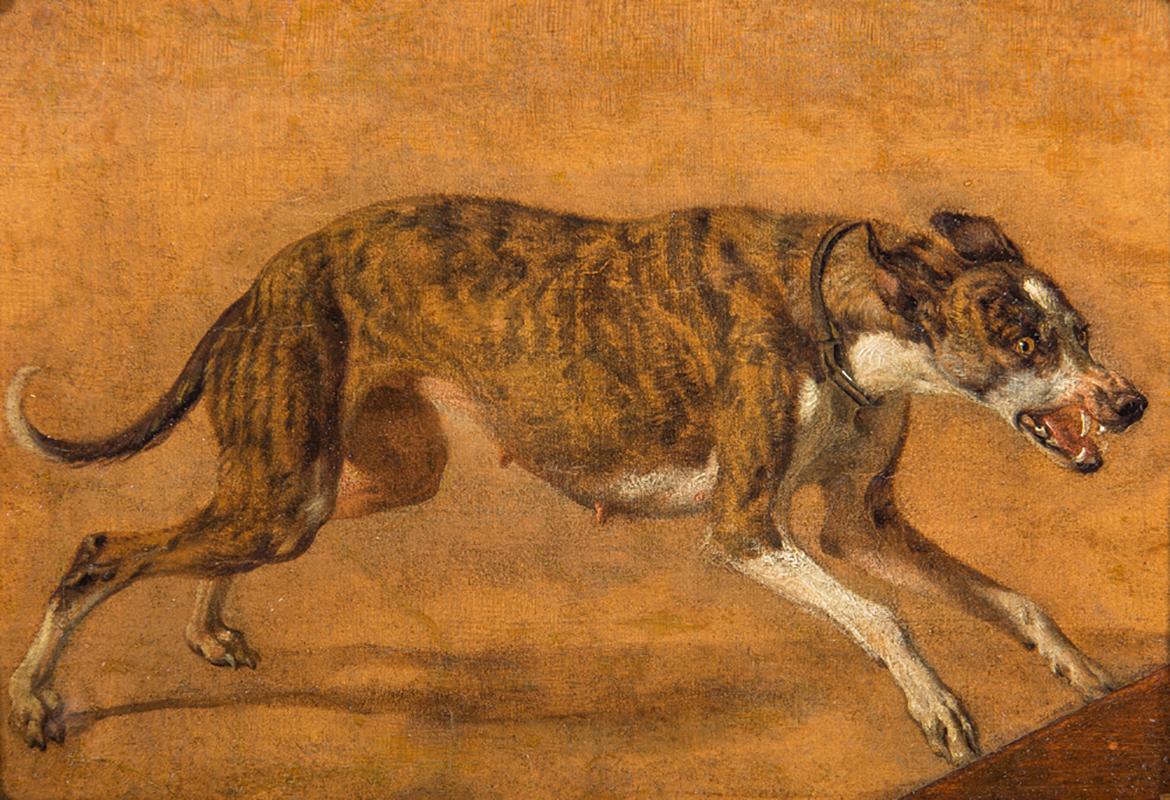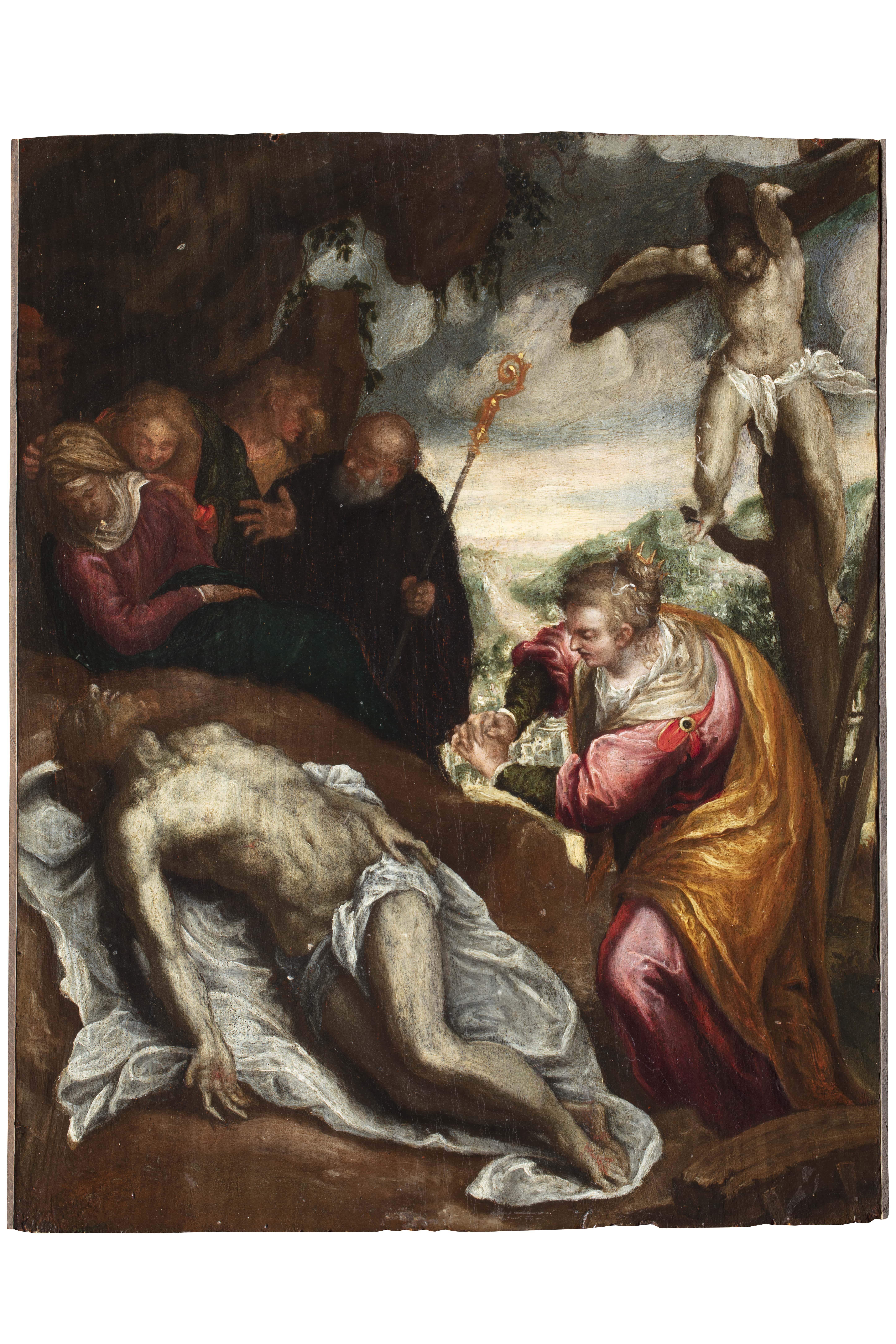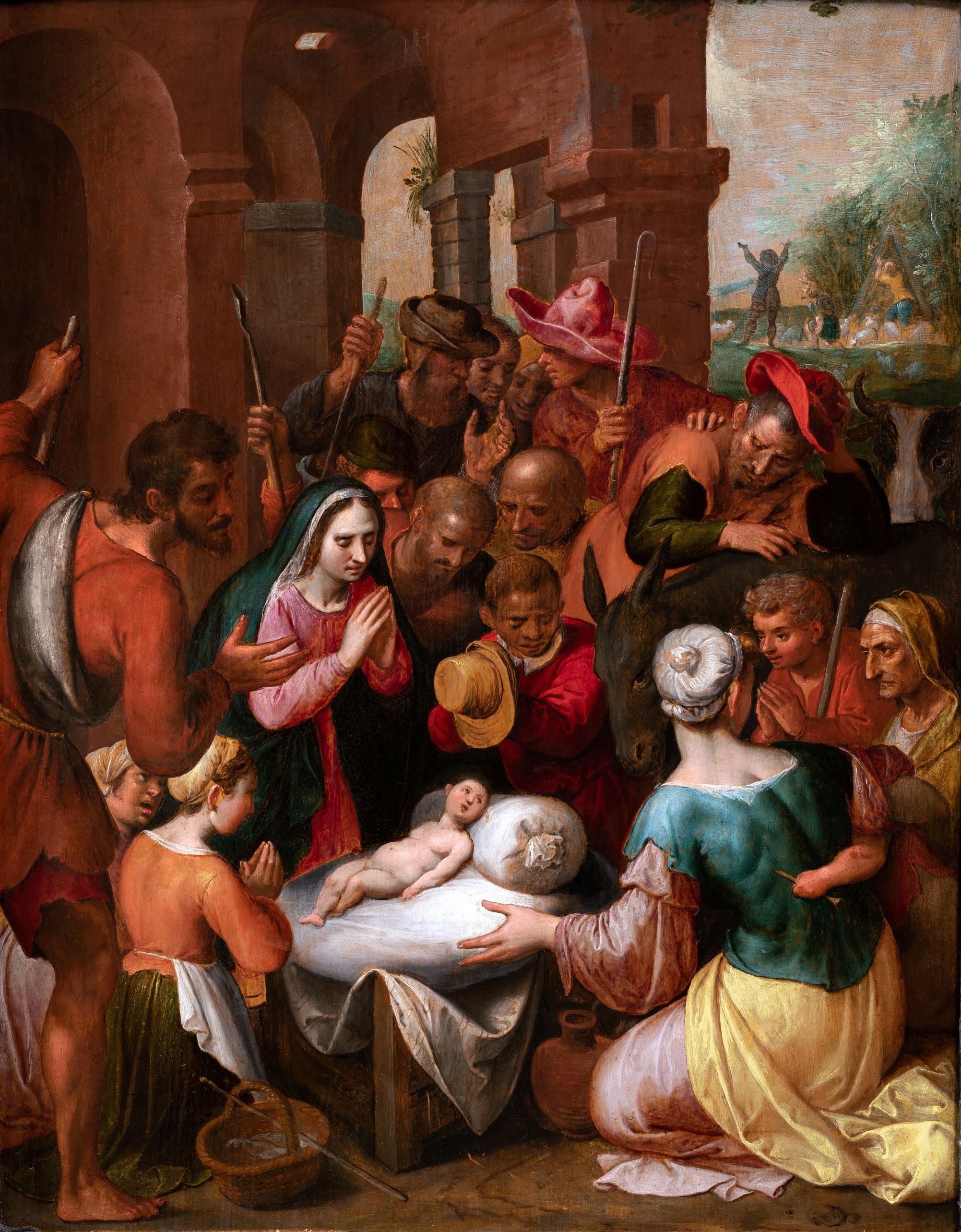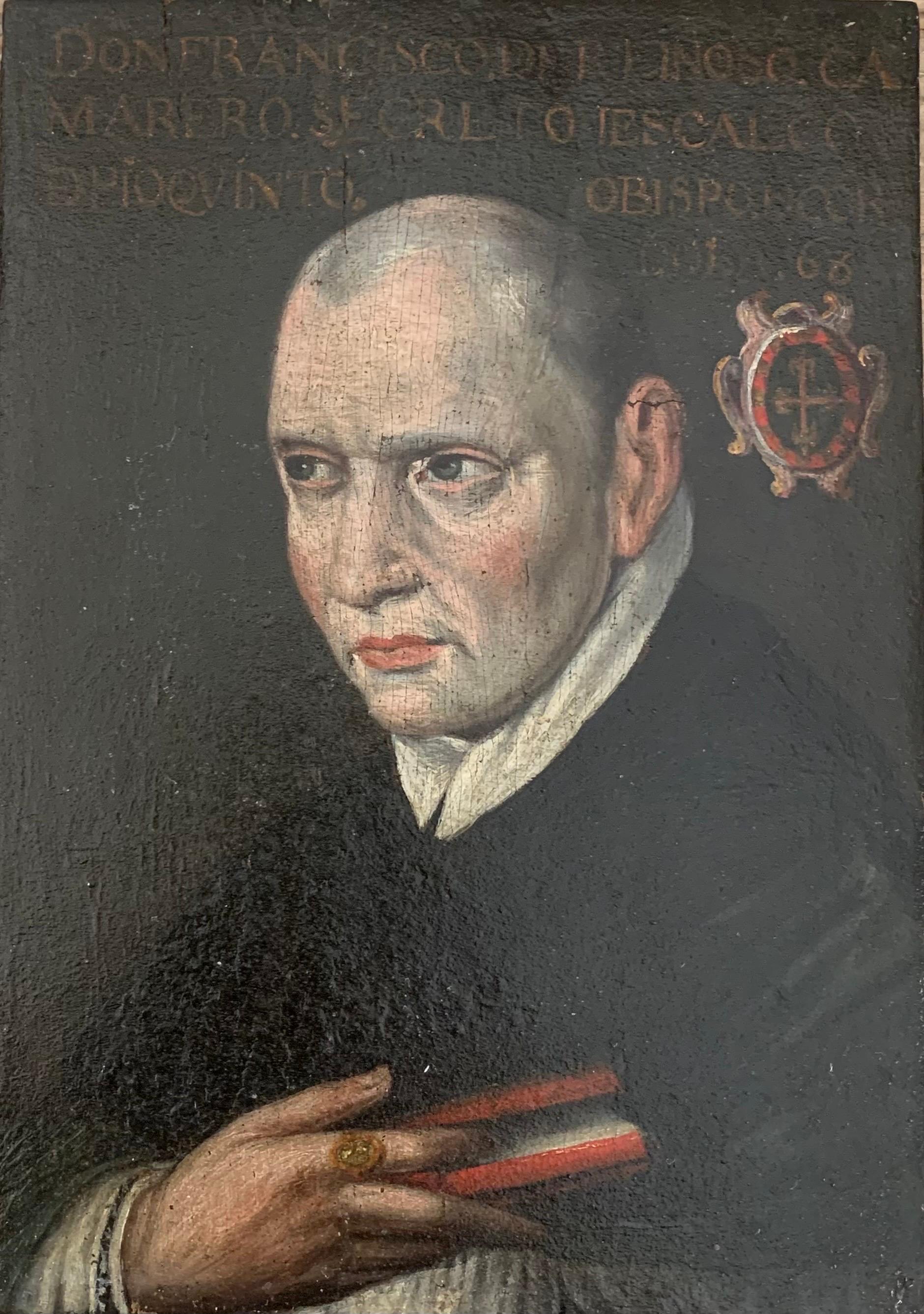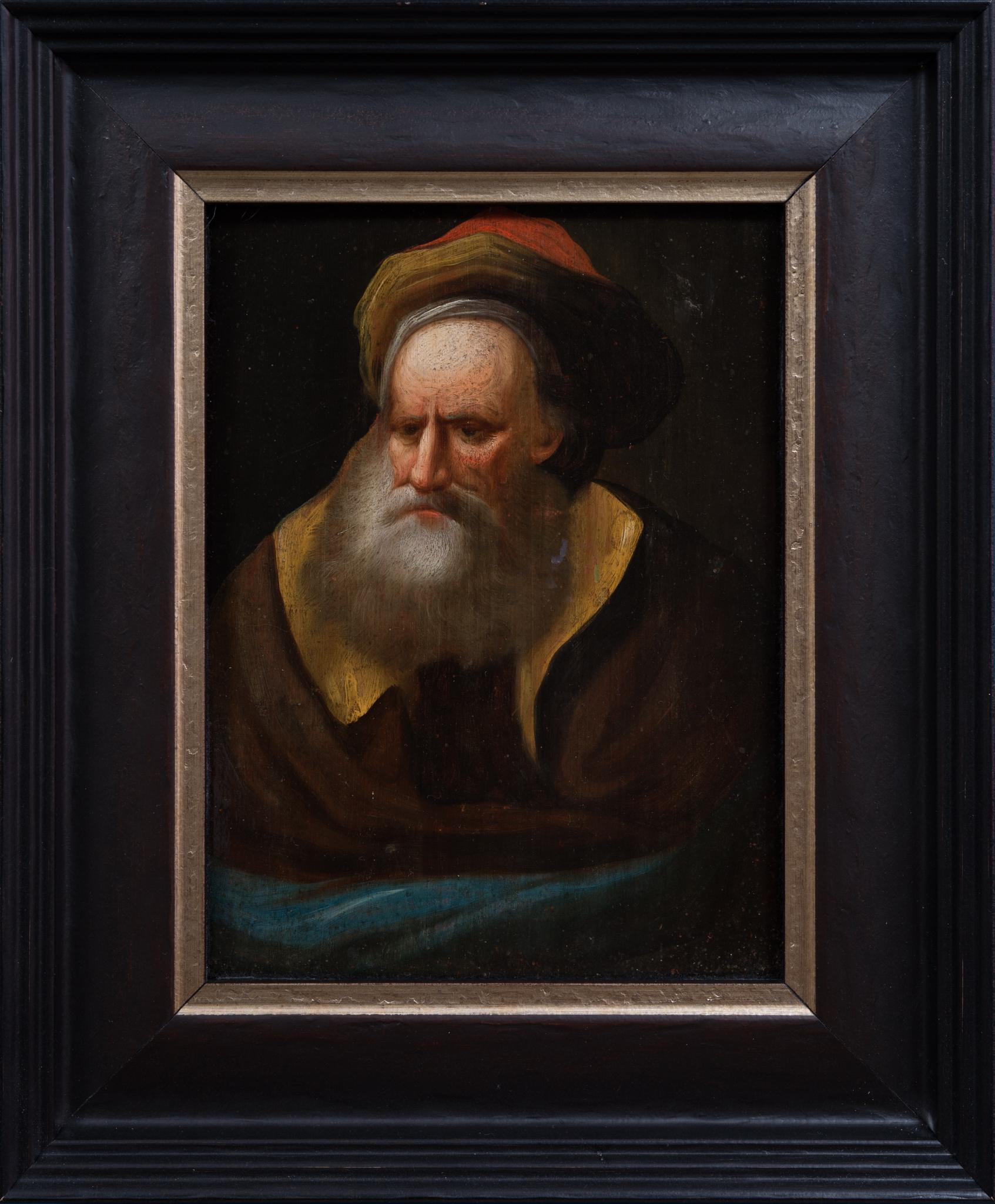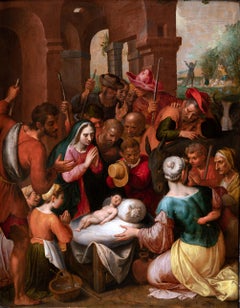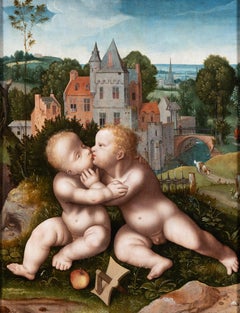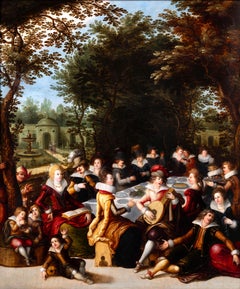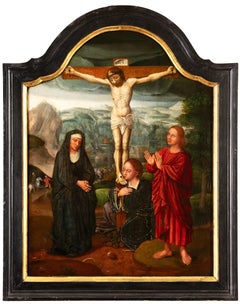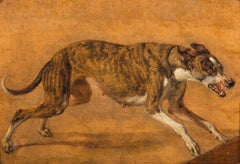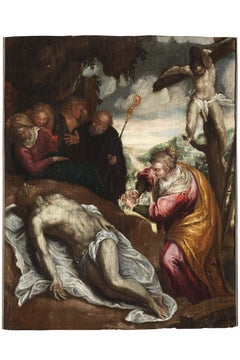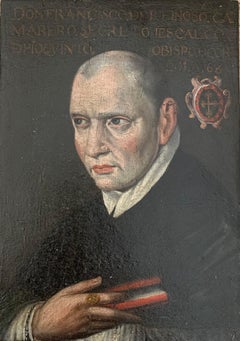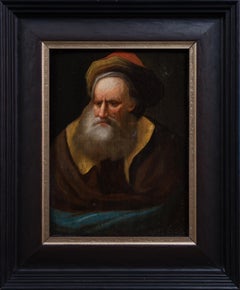Items Similar to Virgin with Child, studio of Adriaen Isenbrant, Bruges, Flemish, 16th century
Want more images or videos?
Request additional images or videos from the seller
1 of 17
Virgin with Child, studio of Adriaen Isenbrant, Bruges, Flemish, 16th century
About the Item
Virgin and Child
Workshop of Adriaen Isenbrant (1480–1551)
Bruges, 16th century
Oil on oak panel
Dimensions: h. 91 cm, w. 73 cm
Large ebonized and giltwood frame called “Carlo Maratta”, Italy, 17th century period
Framed: h. 120 cm, w. 101 cm
Our panel presents the Virgin and Jesus in a moving and intimate setting filled with love.
Mary, depicted half-length, tenderly embraces Jesus, who is standing on her thighs. The child presses his cheek against his mother's, and all the tenderness emanating from this embrace permeates our work.
The Virgin is dressed in a bright red dress and a cloak held by pearl clasps at her shoulders. Jesus, completely naked, is covered by a transparent veil. His white skin contrasts with the vermillion red of the Virgin's clothes.
Mary wears a turban that partially covers her long hair, which falls in curly locks on either side of her shoulders. Depicted in a pensive attitude, her eyes half-closed, she seems to be pondering her son's destiny. While the young child, his eyes open, looks at his mother with affection. Their faces pressed together, their lips advancing as if for a kiss.
The fabrics, artistically arranged in a multitude of broken folds, attract the eye with their intense red appearance, while the edges of the coat, embroidered with gold thread with scroll patterns and adorned with pearls, demonstrate the artist's particular attention to the details of the clothing.
A powerful light illuminates The Virgin and her son, making their flesh translucent.
Our painting is an exquisite work where the finesse of the lines, the play of light, the facial expressions attest to the artist's remarkable mastery and know-how. The painter succeeds in conveying the atmosphere of serenity and gentleness that reigns in this painting. The bright red and the translucent flesh clash to charge our work with an emotional force far beyond an aesthetic aspect.
Our work belongs to a group of similar paintings all based on a lost work by Rogier Van Der Weyden depicting the Virgin and Child, known today from a drawing preserved in the Dresden collection of prints and drawings. This composition, painted around the middle of the 15th century, through the proximity of the two protagonists humanizes the scene and increases its emotional power for the viewer, was, generally speaking, a novelty in Northern Europe in the 15th century.
This approach establishing the intimate bond between mother and child particularly inspired the artists of the Bruges school, who adapted Van der Weyden's composition. Art historians generally attribute the variants either to Adriaen Isenbrant and his students or to Ambrosius Benson and his sons.
Most versions known to date depict the two figures against a plain black background, which is thought to be associated with Adriaen Isenbrant, while those depicted against a landscape or rose garden are thought to belong to the brush of Ambrosius Benson and his workshop.
The plain black background facilitated a better contemplation of the work, preventing the eye from becoming distracted and lost in superficial details.
Related works:
• Provincial Museum of Zaragoza, Adrien Isenbrandt or Willem Benson, (black background) h. 90 cm, l. 60 cm, inv. 231
• Museum of Fine Arts of Seville, around 1550, Ambrosius Benson (black background), h. 92 cm, l. 76 cm, inv. CE0020P
• Auction, Dorotheum, Vienna, October 20, 2015, workshop of A. Benson (rose garden)
• Museum of Fine Arts of Budapest, around 1510, Adrien Isenbrandt (black background), h. 107 cm, l. 69 cm, inv. 5031
Curiously, a Roemer glass filled with tulips appears floating in the shadows of the black background. This bouquet was added in the 17th century by an anonymous artist. Given the popularity of tulips and the craze for still lifes, this is a kind of offering to the Virgin in the form of a painted bouquet.
Adriaen Isenbrant (between 1480 and 1490 - July 1551, Bruges)
The name of Adriaen Isenbrant remains, among those of the Bruges artists of the 16th century, one of the most famous as well as one of the most mysterious. He represents, with Ambrosius Benson, the principal representative of the Bruges school of the first half of the century and yet concrete evidence of his life is lacking. We do not know of any signed works by him but his activity is attested by a rare production of which the examples were multiplied by a large workshop.
Trained in the workshop of Gerard David, he settled in Bruges where he obtained the right of citizenship in 1510. At the head of his workshop, he spread widely in Bruges, responding, it seems, to both public commissions (the decorative work for the Joyous Entry of Charles V) and private ones. Nourished primarily by the examples of his master, whose motifs he often borrows almost literally, his art also draws from beyond, from the art of Van Eyck, Hugo van der Goes or Memling.
His style, "deliberately pictorial" to use the words of Till-Holgert Borchert, is defined by a great softness of modeling, by a delicacy and precision in the execution of details, by delicate and typical faces.
- Attributed to:Adriaen Isenbrant (1480 - 1551, Flemish)
- Dimensions:Height: 47.24 in (119.99 cm)Width: 39.76 in (101 cm)
- Medium:
- Movement & Style:
- Period:
- Condition:
- Gallery Location:PARIS, FR
- Reference Number:1stDibs: LU2433216378792
About the Seller
No Reviews Yet
Vetted Professional Seller
Every seller passes strict standards for authenticity and reliability
1stDibs seller since 2023
15 sales on 1stDibs
Typical response time: 1 to 2 days
- ShippingRetrieving quote...Shipping from: PARIS, France
- Return Policy
Authenticity Guarantee
In the unlikely event there’s an issue with an item’s authenticity, contact us within 1 year for a full refund. DetailsMoney-Back Guarantee
If your item is not as described, is damaged in transit, or does not arrive, contact us within 7 days for a full refund. Details24-Hour Cancellation
You have a 24-hour grace period in which to reconsider your purchase, with no questions asked.Vetted Professional Sellers
Our world-class sellers must adhere to strict standards for service and quality, maintaining the integrity of our listings.Price-Match Guarantee
If you find that a seller listed the same item for a lower price elsewhere, we’ll match it.Trusted Global Delivery
Our best-in-class carrier network provides specialized shipping options worldwide, including custom delivery.More From This Seller
View AllCercle of Ambrosius Francken, Adoration of the shepherds, 17th century Antwerp
Located in PARIS, FR
Adoration of the shepherds,
Cercle of Ambrosius Francken,
Early 17th century Antwerp school
Oil on oak panel: h. 55 cm, w. 43 cm (21.65 in x 16.93 in)
17th c. ebonized and moulded f...
Category
Early 17th Century Old Masters Figurative Paintings
Materials
Oil, Wood Panel
Christ and St John the Baptist as children, studio of J. van Cleve, 16th Flemish
By Joos van Cleve
Located in PARIS, FR
Christ and St John the Baptist embracing
Studio of Joos van Cleve (1485 – 1541), Antwerp
First half of 16th century
Oil on oak panel, h. 55 cm, w. 43 cm
A 17th century ebonized wood frame
Framed: h. 100 cm, w. 83 cm
Provenance:
• Advertisement in Burlington Magazine, 1929, at the antique dealer Paul Larsen, 34 Duke's Street, London, United Kingdom
• Clowes Sale, Christie's London, 7 July 1950, lot 153 (as Joos Van Cleve)
• Acquired from the Katz antique dealers in Dieren (Netherlands) in the 1950s (one of the most important art galleries in the Netherlands specialising in Old Masters)
• By descent, private European collection
The composition of our painting depicting two naked babies embracing, Jesus and Saint John the Baptist, draws its source from a drawing by Leonardo da Vinci, probably executed in Milan around 1490 (kept at Windsor Castle, United Kingdom).
This scheme, widespread early in the Lombard school, was widely reproduced by Leonardo's Milanese followers (Marco d'Oggiono, Bernardino de Conti or Bernardino Luini.)
It is very likely that Joos Van Cleve was inspired by one of the works of his artists during his stay in Italy, however some historians hypothesize that he borrowed the figures from the painting by Marco d'Oggiono who had copied it on site in Flanders (it would have belonged to Margaret of...
Category
16th Century Old Masters Figurative Paintings
Materials
Oil, Wood Panel
Feast in the Garden of Love, 17th century Antwerp, Louis de Caullery
Located in PARIS, FR
Louis de Caullery (1582-1621)
Antwerp School early 17th century
Oil on oak panel
Dimensions: h. 51 cm (20.08 in), w. 43 cm (16.93 in)
Ebonized wooden frame
Framed: h. 67 cm (26.38 in...
Category
Early 17th Century Old Masters Figurative Paintings
Materials
Oil, Wood Panel
Crucifixion, Bruges school, Flemish, mid 16th century
Located in PARIS, FR
Crucifixion, cercle of Adriaen Isenbrandt, mid 16th century
School of Bruges, cercle of Adriaen Isenbrandt (actif 1510-1551)
Oil on oak panel with its original ebonized frame
Dimensi...
Category
16th Century Old Masters Figurative Paintings
Materials
Oak, Oil, Wood Panel
Hieronymus FRANCKEN III - The Denial of Saint Peter, 17th c. Antwerp school
Located in PARIS, FR
Hieronymus FRANCKEN III (Antwerp 1611 - 1671)
17th century Antwerp School
The Denial of Saint Peter
Oil on panel, dim. h. 53 cm, l. 76 cm
Framed, h. 82 cm, l. 106 cm
Sold with the ...
Category
Mid-17th Century Old Masters Figurative Paintings
Materials
Oil, Wood Panel
Saint Jerome, Antwerp, 16th century, circa 1550, cercle of Lambert Van Noort
Located in PARIS, FR
Saint Jerome in the desert
Cercle of Lambert Van Noort (1520-1571, Antwerp)
Antwerp School, mid-16th century
Oil on oak panel.
Dimensions: panel h. 69 cm (27.16 in), l. 52.5 cm (20.6...
Category
16th Century Old Masters Figurative Paintings
Materials
Oil, Wood Panel
You May Also Like
Study of a dog
Located in Amsterdam, NL
Study of a dog
Oil on paper laid down on panel, 17.5 x 25.5 cm
Provenance
Private collection, the Netherlands
Note:
We are grateful to Mr Fred Meijer for his attribution to Ludolf de Jongh
Ludolf de Jongh was the son of a shoemaker. When his father moved to Rotterdam, the young Ludolf decided to learn art rather than shoemaking and became a pupil of Cornelis Saftleven. Later he studied under Anthony Palamedes in Delft and still later with Jan van Bijlert in Utrecht.
In 1635 he travelled to France with Francis Bacon. Seven years later, in 1642, he returned to the Netherlands when he heard that his mother had fallen ill. He set up a shop in Rotterdam, and his earliest signed paintings date from that year.
According to Houbraken, his travels had caused him to speak French so fluently, that his parents had to learn French in order to speak with him.
De Jongh’s work shows a strong influence from the Utrecht school of Caravaggio admirers, especially Jacob Duck...
Category
Mid-17th Century Old Masters Animal Paintings
Materials
Paper, Oil, Wood Panel
16th Century by Venetian Maestro Deposition of Christ Oil on Panel
Located in Milano, Lombardia
16th Century Venetian Maestro
Title: Deposition of Christ
Medium: Oil on panel
Dimensions: without frame 40 x 25 cm
Formerly Canesso Collection, Paris.
Fairs: The International Biennial of Antiques in Florence 2022 (BIAF, Biennale Internazionale dell’Antiquariato di Firenze)
Publications: Bozzetti, modelletti, sketches: dalla collezione di Giorgio Baratti (From the Giorgio Baratti Collection) curated by Anna Orlando, Agnese Marengo and Annalisa Scarpa, Genoa, 2022, pp. 22, 23.
In this precious panel we can admire a lament over the body of Christ by a large group of bystanders among whom we can recognise the Virgin and, in the foreground, St Catherine of Alexandria...
Category
16th Century Old Masters Figurative Paintings
Materials
Oil, Wood Panel
Spanish school. Secretary of Pope Pius V, abbot of Husillos, bishop of Córdoba.
Located in Firenze, IT
Portrait of Francisco de Reynoso y Baeza.
Secretary of Pope Pius V, abbot of Husillos and bishop of Córdoba. Francisci de Reynoso.
Early 17th century.
Small-format portrait from the late Renaissance period.
Spanish school.
Size: Cm 19 x Cm 13.5
Oil on wooden panel.
On the back the fine tablet is strengthened (already in ancient times) by a sheet of parchment.
About 1600-1610.
As often in Mannerist / Late Renaissance portraits, the image of the character is accompanied by the writing that runs at the top, adding a celebratory, historicising touch to the effigy. Let's bring back the sentence here:
DON FRANCISCO DE REINOSO. CAMARERO SECRETO IESCALCO PIO QUINTO OBISCOPO CORDOBA. 68 (? O 7?)
(1534, Autillo de Campos, Spain - 1601, Córdoba)
Francisco de Reynoso was a Spanish cleric, chief chamberlain, and secretary to Pope Pius V, abbot of Husillos, and bishop of Córdoba.
He was the fourth of eleven children. His father was the seventh Lord of Autillo de Campos, and his mother was Juana de Baeza y de las Casas, daughter of Manuel de Baeza, a lawyer of the Royal Council and at the Court of Valladolid.
Francisco de Reynoso was deeply devoted to the Virgin Mary and showed a strong inclination toward religion and piety from an early age.
He studied Latin, arts, and theology at the University of Salamanca.
In 1562, he traveled to Rome with his brothers Pedro and Luis.
In January 1566, following the death of Pope Pius IV, Cardinal Antonio Michele Ghislieri was elected pope, becoming Pius V. From this period until Ghislieri's death in 1572, Francisco de Reynoso served as his chief chamberlain and secretary.
After Pope Pius V died, Francisco de Reynoso returned to Spain and lived for several years in the city of Palencia, where his brother Manuel was a canon.
He supported the Society of Jesus when it was established in Palencia, providing alms to the school's clergy and funding chairs of Letters and Theology at his own expense, as well as donating a significant number of books.
During the brief outbreak of the Black Plague...
Category
17th Century Old Masters Portrait Paintings
Materials
Parchment Paper, Oil, Wood Panel
Portrait of an Old Bearded Man
Located in Stockholm, SE
We are pleased to offer a captivating portrait, most likely painted in the late 18th century, attributed to an artist within the circle of Christian Wilhelm Ernst Dietrich. This oil ...
Category
Late 18th Century Old Masters Portrait Paintings
Materials
Oil, Wood Panel
Titian's Studio
Located in Milford, NH
A wonderfully detailed interior genre oil painting by Flemish artist Louis Tielemans (1826-1856). Tielemans was born in Anvers, and became known for his active genre scenes, emulatin...
Category
Mid-19th Century Old Masters Interior Paintings
Materials
Oil, Wood Panel
Bedouin at Prayer, Orientalist Oil Painting on Panel by Rudolf Ernst
By Rudolf Ernst
Located in Long Island City, NY
This painting by Orientalist artist Rudolf Ernst depicts a Muslim man in quiet contemplation during prayer. He kneels in solitude in the vast desert as the light fades around him. Ma...
Category
1890s Old Masters Figurative Paintings
Materials
Oil, Wood Panel
